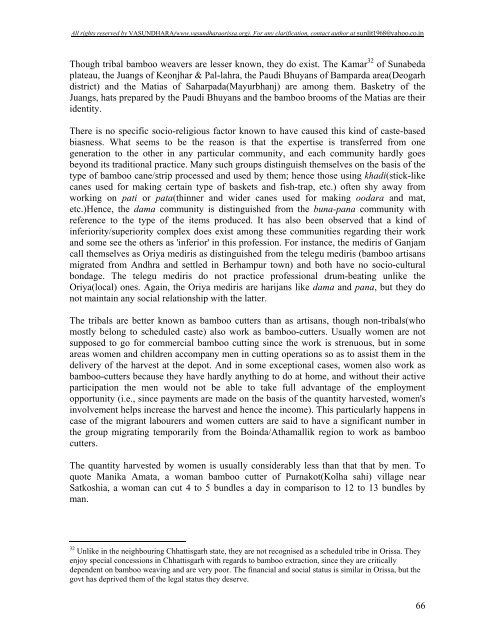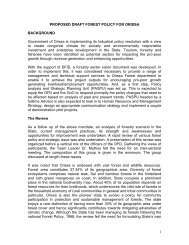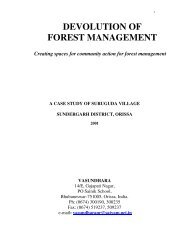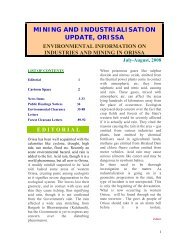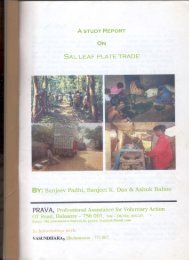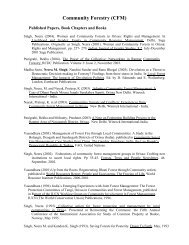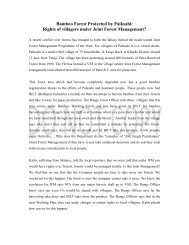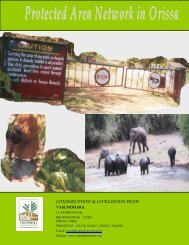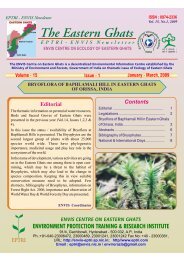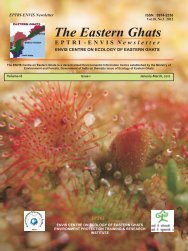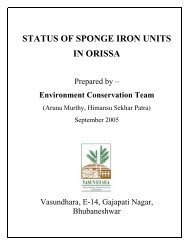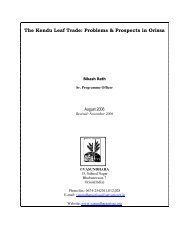Bamboo in Orissa: Trade and Livelihood Perspective - Vasundhara
Bamboo in Orissa: Trade and Livelihood Perspective - Vasundhara
Bamboo in Orissa: Trade and Livelihood Perspective - Vasundhara
Create successful ePaper yourself
Turn your PDF publications into a flip-book with our unique Google optimized e-Paper software.
All rights reserved by VASUNDHARA(www.vasundharaorissa.org). For any clarification, contact author at sunlit1968@yahoo.co.<strong>in</strong><br />
Though tribal bamboo weavers are lesser known, they do exist. The Kamar 32 of Sunabeda<br />
plateau, the Juangs of Keonjhar & Pal-lahra, the Paudi Bhuyans of Bamparda area(Deogarh<br />
district) <strong>and</strong> the Matias of Saharpada(Mayurbhanj) are among them. Basketry of the<br />
Juangs, hats prepared by the Paudi Bhuyans <strong>and</strong> the bamboo brooms of the Matias are their<br />
identity.<br />
There is no specific socio-religious factor known to have caused this k<strong>in</strong>d of caste-based<br />
biasness. What seems to be the reason is that the expertise is transferred from one<br />
generation to the other <strong>in</strong> any particular community, <strong>and</strong> each community hardly goes<br />
beyond its traditional practice. Many such groups dist<strong>in</strong>guish themselves on the basis of the<br />
type of bamboo cane/strip processed <strong>and</strong> used by them; hence those us<strong>in</strong>g khadi(stick-like<br />
canes used for mak<strong>in</strong>g certa<strong>in</strong> type of baskets <strong>and</strong> fish-trap, etc.) often shy away from<br />
work<strong>in</strong>g on pati or pata(th<strong>in</strong>ner <strong>and</strong> wider canes used for mak<strong>in</strong>g oodara <strong>and</strong> mat,<br />
etc.)Hence, the dama community is dist<strong>in</strong>guished from the buna-pana community with<br />
reference to the type of the items produced. It has also been observed that a k<strong>in</strong>d of<br />
<strong>in</strong>feriority/superiority complex does exist among these communities regard<strong>in</strong>g their work<br />
<strong>and</strong> some see the others as '<strong>in</strong>ferior' <strong>in</strong> this profession. For <strong>in</strong>stance, the mediris of Ganjam<br />
call themselves as Oriya mediris as dist<strong>in</strong>guished from the telegu mediris (bamboo artisans<br />
migrated from Andhra <strong>and</strong> settled <strong>in</strong> Berhampur town) <strong>and</strong> both have no socio-cultural<br />
bondage. The telegu mediris do not practice professional drum-beat<strong>in</strong>g unlike the<br />
Oriya(local) ones. Aga<strong>in</strong>, the Oriya mediris are harijans like dama <strong>and</strong> pana, but they do<br />
not ma<strong>in</strong>ta<strong>in</strong> any social relationship with the latter.<br />
The tribals are better known as bamboo cutters than as artisans, though non-tribals(who<br />
mostly belong to scheduled caste) also work as bamboo-cutters. Usually women are not<br />
supposed to go for commercial bamboo cutt<strong>in</strong>g s<strong>in</strong>ce the work is strenuous, but <strong>in</strong> some<br />
areas women <strong>and</strong> children accompany men <strong>in</strong> cutt<strong>in</strong>g operations so as to assist them <strong>in</strong> the<br />
delivery of the harvest at the depot. And <strong>in</strong> some exceptional cases, women also work as<br />
bamboo-cutters because they have hardly anyth<strong>in</strong>g to do at home, <strong>and</strong> without their active<br />
participation the men would not be able to take full advantage of the employment<br />
opportunity (i.e., s<strong>in</strong>ce payments are made on the basis of the quantity harvested, women's<br />
<strong>in</strong>volvement helps <strong>in</strong>crease the harvest <strong>and</strong> hence the <strong>in</strong>come). This particularly happens <strong>in</strong><br />
case of the migrant labourers <strong>and</strong> women cutters are said to have a significant number <strong>in</strong><br />
the group migrat<strong>in</strong>g temporarily from the Bo<strong>in</strong>da/Athamallik region to work as bamboo<br />
cutters.<br />
The quantity harvested by women is usually considerably less than that that by men. To<br />
quote Manika Amata, a woman bamboo cutter of Purnakot(Kolha sahi) village near<br />
Satkoshia, a woman can cut 4 to 5 bundles a day <strong>in</strong> comparison to 12 to 13 bundles by<br />
man.<br />
32 Unlike <strong>in</strong> the neighbour<strong>in</strong>g Chhattisgarh state, they are not recognised as a scheduled tribe <strong>in</strong> <strong>Orissa</strong>. They<br />
enjoy special concessions <strong>in</strong> Chhattisgarh with regards to bamboo extraction, s<strong>in</strong>ce they are critically<br />
dependent on bamboo weav<strong>in</strong>g <strong>and</strong> are very poor. The f<strong>in</strong>ancial <strong>and</strong> social status is similar <strong>in</strong> <strong>Orissa</strong>, but the<br />
govt has deprived them of the legal status they deserve.<br />
66


